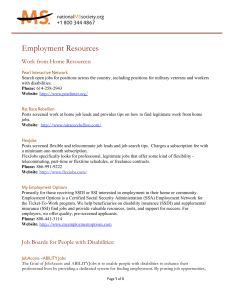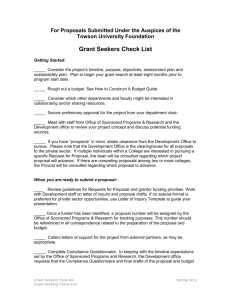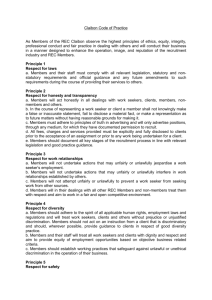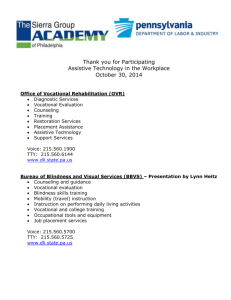You are talking about a new business model?
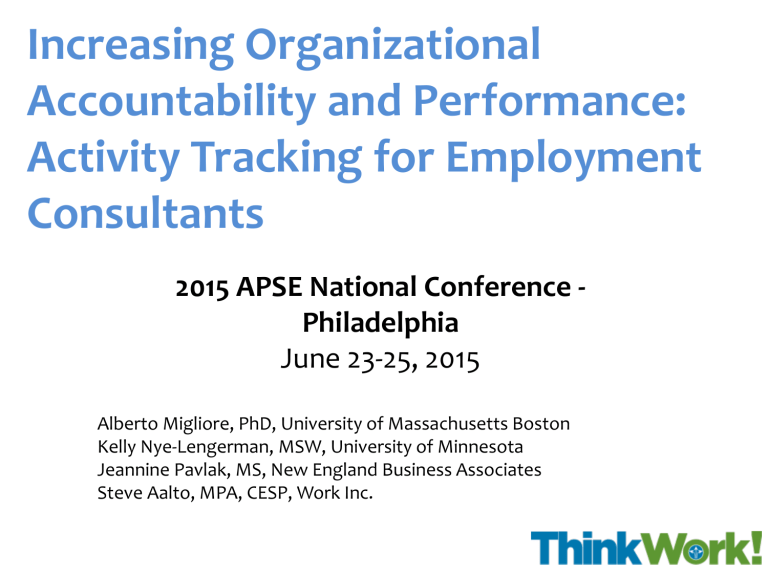
Increasing Organizational
Accountability and Performance:
Activity Tracking for Employment
Consultants
2015 APSE National Conference -
Philadelphia
June 23-25, 2015
Alberto Migliore, PhD, University of Massachusetts Boston
Kelly Nye-Lengerman, MSW, University of Minnesota
Jeannine Pavlak, MS, New England Business Associates
Steve Aalto, MPA, CESP, Work Inc.
Agenda
Introduction
Theory
Examples From Research
Examples From the Field
Q & A
Definitions
Employment consultants (ECs) are staff members in employment programs who assist job seekers with disabilities in finding employment. They also may be referred to as employment specialists, job developers, rehabilitation counselors, or employment support professionals.
Community rehabilitation programs (CRPs) are non-profit or for-profit, private or public organizations that provide a wide range of services— including employment services—to people with any types of disabilities.
Employment refers to work that pays at least minimum or prevailing wage and that entails working in an environment where the majority of co-workers do not have disabilities
76%
What’s the problem?
Percentage employed
75%
72% 70% 71% 71% 72%
28% 27%
24% 23% 22% 23% 23%
2007 2008 2009 2010 2011 2012 2013
No Disability Cognitive Disability
American Community Survey
$858
Weekly wages (in 2013 dollars)
$853 $859 $833 $824
$211 $207 $205 $208 $202
2004 2005 2006 2007 2008 2009 2010 2011 2012 2013
General population
Intellectual disabilities
American Community Survey
What are the desired goals?
Higher employment rates
Higher wages and more work hours
Longer job retention
Career advancement
Any good news? Yes!
Employment first policies (12 states)
DoJ scrutiny on day programs
WIOA new provisions
Families’ higher expectations
Big picture
CRPs
ECs
Focus on Employment Consultants (EC)
“ …Regardless of the job seeker ’ s level of motivation, skill, experience, attitude, and support system, his or her ability to get a job will often depend on the effectiveness of employment specialists…
Simply stated, if they (employment
specialists) are good, job seekers get jobs. If they are not, the barriers to employment for job seekers can become insurmountable… ”
(Lueking et al., 2004, p. 29)
What do we know about ECs?
Estimated 35,000 employment consultants serving the IDD population, nationally
The majority of ECs support up to five job seekers with IDD per year in getting employment (60%)
73% of job seekers makes $8 per hour or less
62% of job seekers work 20 or less hours/week
Migliore et al, 2010
Part II
Theory
How to improve outcomes?
All organizational results are the product of behavior…
To improve results, you must first get people to change what they do…
Do it either more often, or less often, or do it entirely different…
Aubrey & Bailey, 2014
Heath & Heath, 2010 http://www.slideshare.net/mnceeInEx/using-behavior-change-principles-to-increase-the-performance-of-traditional-residential-energy-efficiency-programs
Direct the rider: Clarify goals
Identify what needs to be done
precisely define your expectations
Pinpoint the results you want
Daniels & Bailey, 2014; Drucker 2004
Examples of What Needs to be Done
Getting to know job seekers
Searching for jobs
Engaging employers to hire
Support after hire
Direct the rider: Measure progress
If you don’t measure it, you can’t tell if things are getting better, getting worse, or staying the same
Measurement allows you to see smaller changes in performance than you could NOT see through casual observation
People need useful information on how they are doing (i.e. feedback).
Daniels & Bailey, 2014
Direct the rider: Measure progress
Time is the scarcest and most precious resource we have...
A first step toward effectiveness is to record actual time use…
Without an action plan one becomes prisoner of events, without a way of assessing which events really matter
(Peter Drucker, 2004, p. 35)
Direct the rider: Measure progress
“…somehow you want to send the message clearly without getting people down. You can do that with numbers. People hear the message backed by numbers loud and clear. They say, ‘Boy, we’ve got to do something about that’…”
(Stack & Burlingham, 2013, p. 106)
Motivate the elephant
Highlight successes
Share success stories, tips, and peer-topeer encouragement
People do better when they are happy, have positive views of their organization
Believe that our work is contributing to something that matters…
(Amabile & Kramer, 2011; Heath & Heath, 2010; Stack & Burlingham, 2013).
Shape the path
Provide tools:
knowledge
Technology
Leadership
Supports
Part III
Examples from Research
Research
Employment consultants (EC) survey (2009)
Pilot activity log (2013)
Community Rehabilitation Programs survey (2014)
Employment consultants Interviews (2015)
Daily survey (2016)
What Domains have we Measured?
Getting to know job seekers
Searching for jobs
Engaging employers to hire
Support after hire
What Tools Have We Used?
Survey: Multiple choice/Likert scale
Activity log on paper
Daily survey for smart phones (in progress)
Example of Survey
Example of Survey findings
Percentage of ECs performing these activities for most or all job seekers… to get to know job seekers
Talked to acquaintances
Talked to former employers
Situational assessment
Observation in non-work environment
Talked to family members
Talked to referral and funding agencies
Facilitated/attended person centered planning
0%
N= 163 Ecs in 28 states
17%
19%
25%
38%
43%
54%
59%
61%
50% 75% 100%
…to search for jobs?
One-Stop Career Centers
Searched without referrals in mind*
Negotiated job descriptions
Knocked on doors of businesses*
Involved family members or…
Asked employers about related…
Attended business events*
Approached past employers
Made cold calls to employers
Reviewed classified ads
0%
*In the past three months
16%
18%
27%
25%
33%
34%
39%
50%
51%
53%
53%
53%
75% 100%
Survey Pros and Cons
Pros
Relatively quick/easy
One-time measure
Allows to track several activities
Cons
Self-reported
Accuracy is an issue
No quantitative measurements
Example of Activity Log
Example of Activity log Findings
Percentage of weekly hours (N=49 ECs)
Adm duties (e.g. Paperwork, meetings, etc)…
Other (12%)
Reviewing job ads in newspapers, internet,…
At JS s workplace (e.g., job coaching,…
With job seekers for career planning (9%)
Traveling with JS (e.g. to work or…
At work sites for job exploration (6%)
With case managers, Residential, referrals,…
Outreach not on behalf of a specific JS (e.g…
With empl/their reprs. for job…
Coaching business personnel, checking on…
With family members or acquaintances (1%) 1%
3%
5%
5%
7%
6%
5%
10%
9%
9%
12%
28%
Activity Log Pros and Cons
Pros
More Precise (Tracks 30 minutes periods)
More Objective
Cons
Limited number of activities tracked
Time consuming/distracting
People may forget
What’s next?
Daily Survey for Smart Phones
Pros and Cons
Pros
More activities tracked: What, Who, and Where and their combination
Precise (30 minutes periods)
Immediate
Less disruptive
Longer data collection (1 year)
Cons
Not everybody have smart phones
Requires connectivity to a cellular network
Samples only 30 minutes per day
What Data Tracking Tools do CRPs use?
136 CRPs in 37 states in USA
57%
22%
14%
Excel, Access, or paper
Web-based Do not track activities
7%
Other
What Web-based tools are available?
set-works.com
salesforce.com
therapservices.net
State-provided tools
Agency developed tools
Part IV
Examples from the Field:
NEBA
Please request the slides to Jeannine
Pavlak at jeannine.pavlak@nebaworks.com
Work Inc.
Please request the slides to Steve Aalto at
Saalto@workinc.org
Conclusions
Use data to drive performance
Explore what others do
Start low tech
Invest in technology
Try, assess, revise, repeat
Questions?
References
Amabile, T., & Kramer, S. (2011) The progress principle: using small wins to ignite joy, engagement, and creativity at work. Cambridge, MA: Harvard Business School Publishing.
Butterworth, J., Migliore, A., Nord, D., Gelb, A. (2012). Improving the employment outcomes of job seekers with intellectual and developmental disabilities: A training and mentoring intervention for employment consultants. Journal of Rehabilitation, 78 (2), 20-29.
Butterworth, J., Winsor, J., Smith, F. A., Migliore, A., Domin, D, Ciulla Timmons, J. & Hall, A.C. (2015).
StateData: The national report on employment services and outcomes. Boston, MA: University of
Massachusetts Boston, Institute for Community Inclusion.
Daniels AC & Bailey JS (2014) Performance Management: Changing behavior that drives organizational effectiveness (5th edition) Atlanta GA: Performance Management Publications
Drucker, P., F. (2004) The Effective Executive: The Definitive Guide to Getting the Right Things Done.
New York, NY: HarperCollins Publisher Inc.
Few, F. (2006) Information Dashboard Design: The Effective Visual Communication of Data. Sebastopol,
CA. O’Reilly Media Inc.
Heath, C. and Heath, D. (2010) Switch: How to Change Things When Change Is Hard. New York, NY:
Broadway Books.
Luecking, R. G., Fabian, E. S., & Tilson, G. P. (2004). Working relationships: Creating careers for job seekers with disabilities through employer partnerships. Baltimore, MD: Paul H. Brookes Publishing Co.
Migliore, A., Hall, A., Butterworth, J., Winsor, J. (2010) What do employment specialists really do? A study on job development practices. Research and Practice for Persons with Severe Disabilities, 35(1-2),
15-23.
Stack, J., & Burlingham, B. (2013) The Great Game of Business, Expanded and Updated: The Only
Sensible Way to Run a Company. New York, NY. Crown Business.
Contact information
Alberto Migliore, PhD, University of Massachusetts, alberto.Migliore@umb.edu
Kelly Nye-Lengerman, MSW, University of Minnesota knye@umn.edu
Jeannine Pavlak, MS, New England Business Associates jeannine.pavlak@nebaworks.com
Steve Aalto, MPA, CESP, Work Inc.
Saalto@workinc.org
Acknowledgements
Funding for this presentation were through The Rehabilitation
Research and Training Center on Advancing Employment for
Individuals with Intellectual and Developmental Disabilities,
Grant # H133B140026, National Institute on Disability,
Independent Living, and Rehabilitation Research, Administration for Community Living, U.S. Department of Health and Human
Services.
We would like to thank John Butterworth (University of
Massachusetts Boston) and Derek Nord (University of
Minnesota) for their work as team members of the research activities described in this presentation.
